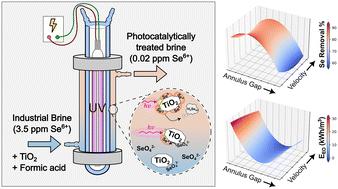当前位置:
X-MOL 学术
›
Environ. Sci.: Nano
›
论文详情
Our official English website, www.x-mol.net, welcomes your feedback! (Note: you will need to create a separate account there.)
Photocatalytic nanoparticles in flow-through annular photoreactors for continuous selenate reduction in industrial wastewater
Environmental Science: Nano ( IF 5.8 ) Pub Date : 2024-06-06 , DOI: 10.1039/d4en00170b Emile Milan 1 , Aldrich Ngan 1 , Jeffrey Watchorn 1, 2 , Zi Qi Chen 1 , Aaron J. Clasky 1 , Frank Gu 1, 2, 3, 4
Environmental Science: Nano ( IF 5.8 ) Pub Date : 2024-06-06 , DOI: 10.1039/d4en00170b Emile Milan 1 , Aldrich Ngan 1 , Jeffrey Watchorn 1, 2 , Zi Qi Chen 1 , Aaron J. Clasky 1 , Frank Gu 1, 2, 3, 4
Affiliation

|
The adverse effect of elevated selenium (Se) levels on aquatic ecosystems continues to drive the development of innovative technologies for treatment of Se-laden industrial effluents to sub-ppb levels. Photocatalysis is a promising water treatment technology that can selectively remove Se from industrial wastewater with minimal residuals. However, despite the reported advantages of photocatalysis across the many studied water treatment applications, the technology sees minimal industrial adoption due to a lack of work done on photoreactor engineering and process scale-up. The work presented herein demonstrates the heterogeneous photocatalytic reduction of selenate (SeO42−) from a synthetic mine-influenced brine (SMIB) using nanoscale TiO2 (n-TiO2) in a continuous annular photoreactor. A Box–Behnken design (BBD) is used to evaluate key parameters on SeO42− removal efficiency and electrical energy per order (EEO), including suspended n-TiO2 loading, concentration of formic acid hole scavenger, reactor annulus gap, and axial flow velocity. The three-level BBD elucidated that the most critical factors influencing SeO42− removal efficiency from SMIB were the TiO2 photocatalyst concentration and axial velocity. On the other hand, the TiO2 concentration and annulus gap were most impactful on the UV electrical energy per order (EEO,UV) response. Se removal from SMIB down to 20 μg L−1 was demonstrated using the continuous annular photoreactor, requiring 7.75 kWh m−3 of UV input. This work serves as the first proof of concept for continuous photocatalytic Se treatment and encourages further development of photocatalytic systems towards scale-up and real-world application.
中文翻译:

流通式环形光反应器中的光催化纳米粒子用于连续减少工业废水中的硒酸盐
硒 (Se) 水平升高对水生生态系统的不利影响继续推动将含硒工业废水处理至亚 ppb 水平的创新技术的发展。光催化是一种很有前景的水处理技术,可以选择性地去除工业废水中的硒,且残留量极低。然而,尽管在许多研究的水处理应用中报道了光催化的优势,但由于缺乏在光反应器工程和工艺放大方面的工作,该技术的工业应用很少。本文介绍的工作演示了使用纳米级 TiO 2 (n -TiO 2 )在连续环形光反应器中。 Box–Behnken 设计 (BBD) 用于评估 SeO 4 2− 去除效率和每阶电能 (E EO ) 的关键参数,包括悬浮n-TiO 2 负载量、甲酸空穴清除剂浓度、反应器环空间隙和轴向流速。三级BBD表明,影响SMIB去除SeO 4 2− 效率的最关键因素是TiO 2 光催化剂浓度和轴向速度。另一方面,TiO 2 浓度和环隙对每级 UV 电能 (E EO,UV ) 响应影响最大。使用连续环形光反应器证明了 SMIB 中 Se 的去除率低至 20 μg L −1 ,需要 7.75 kWh m −3 的 UV 输入。 这项工作是连续光催化硒处理的第一个概念证明,并鼓励进一步开发光催化系统以实现规模化和实际应用。
更新日期:2024-06-06
中文翻译:

流通式环形光反应器中的光催化纳米粒子用于连续减少工业废水中的硒酸盐
硒 (Se) 水平升高对水生生态系统的不利影响继续推动将含硒工业废水处理至亚 ppb 水平的创新技术的发展。光催化是一种很有前景的水处理技术,可以选择性地去除工业废水中的硒,且残留量极低。然而,尽管在许多研究的水处理应用中报道了光催化的优势,但由于缺乏在光反应器工程和工艺放大方面的工作,该技术的工业应用很少。本文介绍的工作演示了使用纳米级 TiO 2 (n -TiO 2 )在连续环形光反应器中。 Box–Behnken 设计 (BBD) 用于评估 SeO 4 2− 去除效率和每阶电能 (E EO ) 的关键参数,包括悬浮n-TiO 2 负载量、甲酸空穴清除剂浓度、反应器环空间隙和轴向流速。三级BBD表明,影响SMIB去除SeO 4 2− 效率的最关键因素是TiO 2 光催化剂浓度和轴向速度。另一方面,TiO 2 浓度和环隙对每级 UV 电能 (E EO,UV ) 响应影响最大。使用连续环形光反应器证明了 SMIB 中 Se 的去除率低至 20 μg L −1 ,需要 7.75 kWh m −3 的 UV 输入。 这项工作是连续光催化硒处理的第一个概念证明,并鼓励进一步开发光催化系统以实现规模化和实际应用。
















































 京公网安备 11010802027423号
京公网安备 11010802027423号